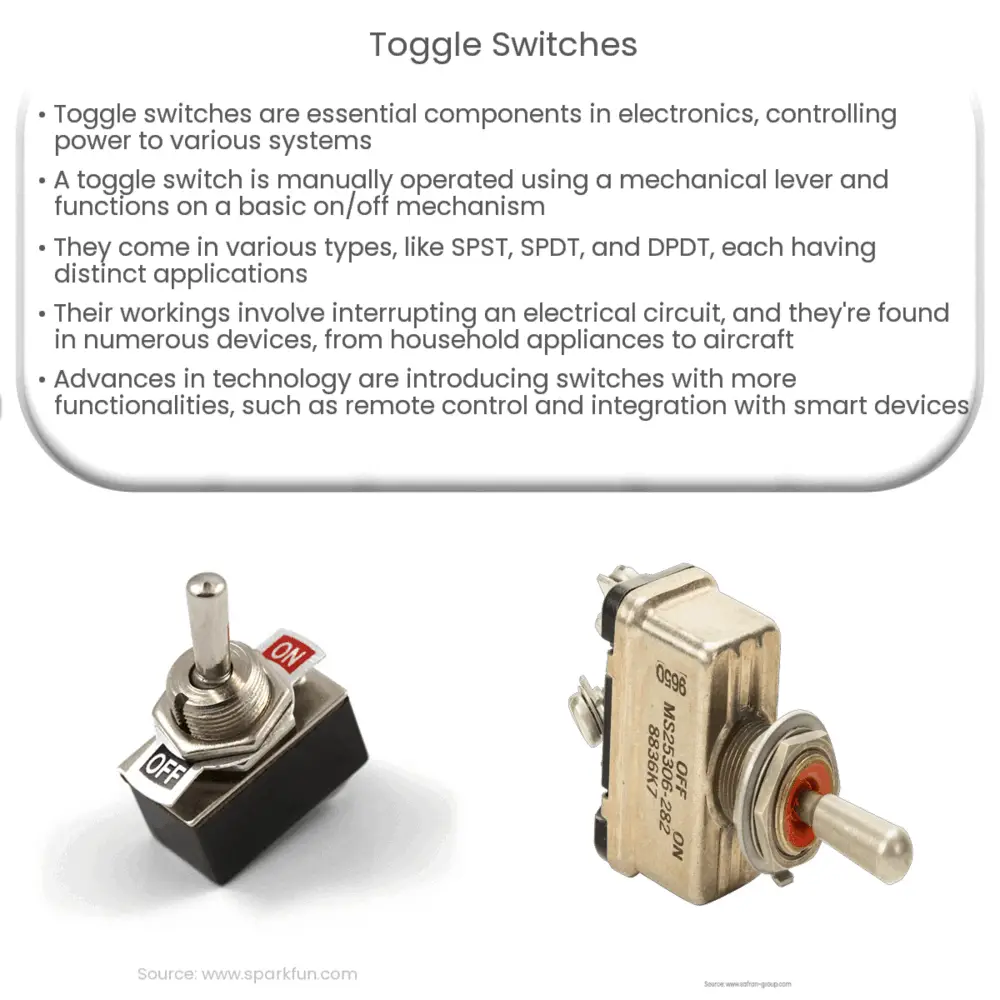Explore the world of toggle switches, their types, working principles, applications, selection criteria, maintenance, and future prospects.

Introduction to Toggle Switches
Toggle switches are a fundamental component in the realm of electronics and electrical systems. They play an indispensable role in our daily life, controlling power to various devices and systems. From turning on a light to powering complex machines, they are the gatekeepers of electrical power.
Definition of Toggle Switch
A toggle switch is a type of electrical switch that is manually actuated (i.e., set in motion) by a mechanical lever, handle, or rocking mechanism. This switch operates on a simple on/off mechanism and can be found in countless devices and machines.
Types of Toggle Switches
SPST (Single Pole Single Throw): The simplest type of toggle switch is the SPST switch. This has two terminals which can either be connected (on) or disconnected (off). These are used in systems that require a single control mechanism, such as a light bulb.
SPDT (Single Pole Double Throw): This type of switch has three terminals. One is the input, and the other two are outputs. The input can be switched between the two output terminals. These are typically used in systems where users need an option between two operational states.
DPDT (Double Pole Double Throw): A DPDT switch has six terminals and can control two circuits simultaneously. This switch is essentially like having two SPDT switches in one package, allowing the user to switch between two different circuits.
How Toggle Switches Work
Toggle switches work on the basic principle of interrupting an electrical circuit. When in the off position, the circuit path is open, preventing the flow of electricity. When flipped to the on position, the circuit path is closed, allowing electricity to flow through the device or system. The internal workings of a toggle switch can be quite complex, involving a series of contacts, springs, and levers.
Applications of Toggle Switches
Toggle switches find applications in a plethora of devices and systems. They are commonly used in household appliances, industrial machinery, aircraft systems, and many more. Some common uses of toggle switches are:
- Light switches
- Industrial controls
- Test and measurement equipment
- Marine panels
Choosing the Right Toggle Switch
Selecting the right toggle switch for a specific application can be a complex process. Factors to consider include the current rating (measured in amperes), the number of poles and throws (determined by the desired level of control), the mounting style, and the type of terminal. Additionally, the environment where the switch will be used can also dictate the choice – for instance, a water-resistant switch might be required in outdoor or marine applications.
The Future of Toggle Switches
While the fundamental design of the toggle switch remains unchanged, advances in technology are leading to switches with increased functionalities. These include switches with built-in LED indicators, programmable switches, and even switches that can be remotely controlled via wireless technology. Furthermore, the advent of smart homes and IoT (Internet of Things) technology has led to the development of ‘smart’ switches that can be controlled via smartphone apps or voice commands.
Maintenance and Safety
Proper maintenance of toggle switches is crucial for their longevity and efficient operation. Regular cleaning and inspection can help identify potential issues before they cause failures. Also, as with any electrical component, safety is paramount. Always ensure that electrical power is disconnected before working on or near a toggle switch. Understanding and adhering to the specifications of a toggle switch, such as its voltage and current ratings, is essential to prevent electrical overload and potential fire hazards.
Conclusion
In conclusion, toggle switches are a fundamental component in electrical systems, playing an indispensable role in a myriad of devices and applications. Despite their simplicity, their impact is significant and far-reaching. From the basic on/off light switch to complex industrial controls, their functionality and reliability make them a cornerstone of modern electrical technology. With ongoing advances in technology and the rise of the Internet of Things, we can anticipate even more innovative uses and adaptations for these versatile switches in the future.

